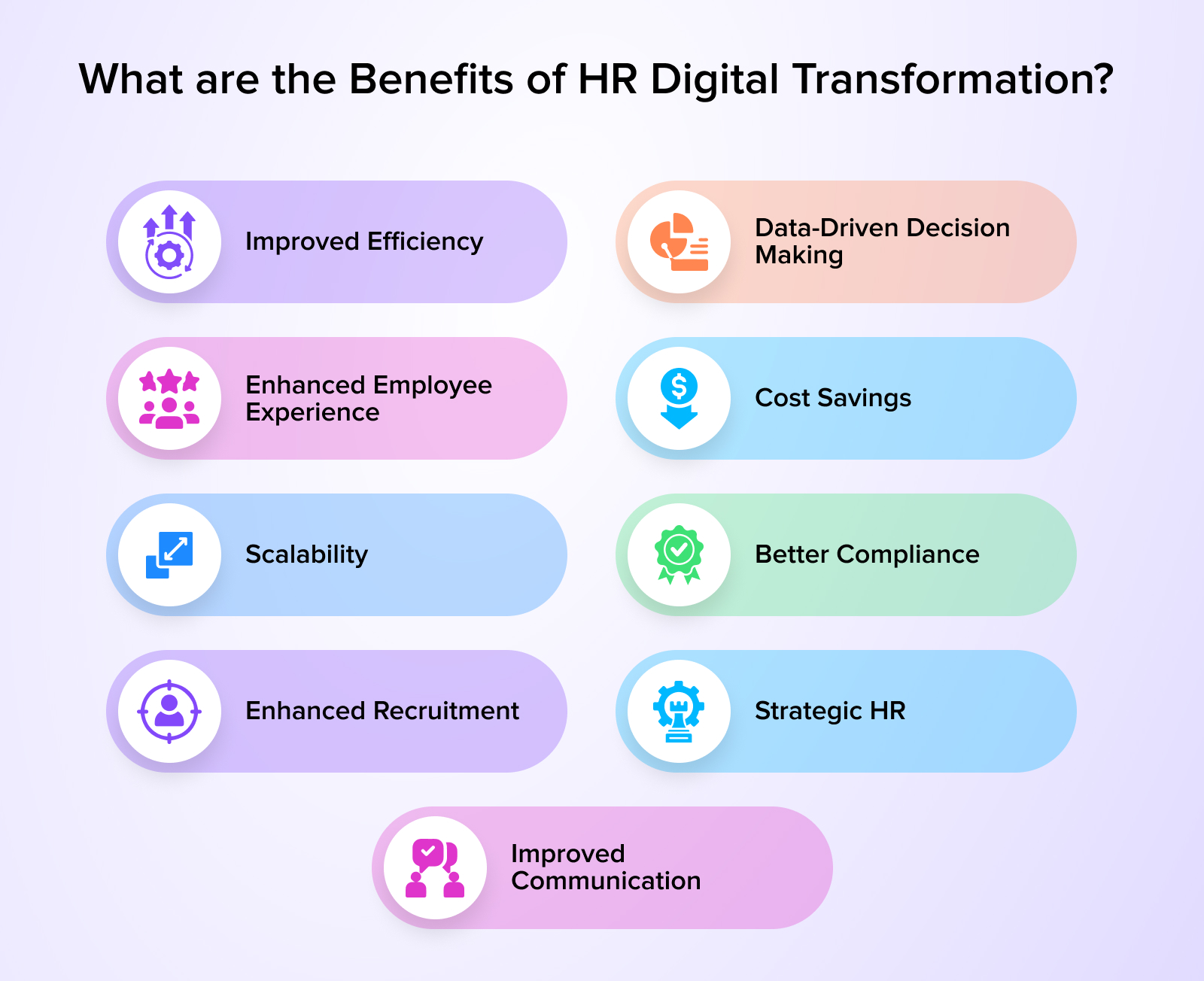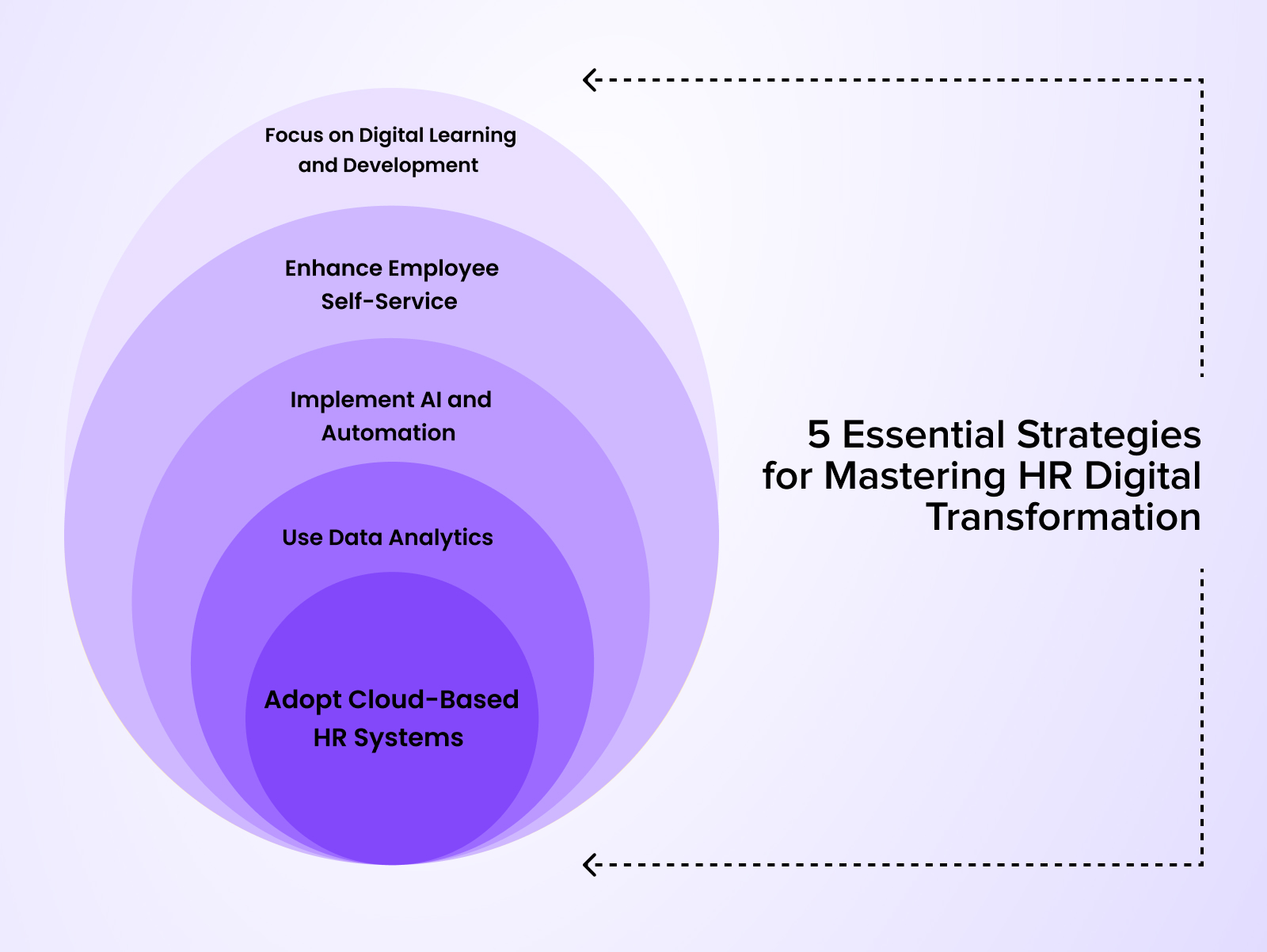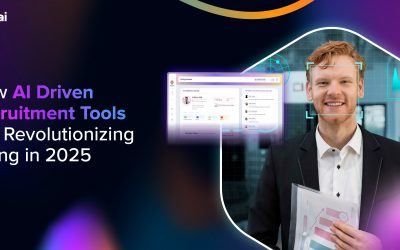In simple words, it’s about using technology and data to make HR smoother, faster, and more focused on people. Imagine a Human Resource team that can automatically handle routine tasks like new hire paperwork and payroll, use data to understand employee needs, and keep everyone connected even if they’re not in the same office. Companies that incorporate HR digital transformation are seeing real results. Studies by Forbes show that these companies experience a whopping 25% reduction in the time they spend on paperwork, freeing them up for more strategic work. That’s a win-win for everyone!
This blog will explore 5 essential strategies to help you master HR digital transformation in 2024. Let’s get your HR team out of the paper pile and into the digital age!
Let’s start this blog by understanding what HR Digital Transformation is.
What is HR Digital Transformation?
HR Digital Transformation refers to integrating digital technologies into all aspects of human resources functions to enhance efficiency, improve employee experience, and streamline HR processes. It’s like giving HR a tech makeover! Digital transformation in HR includes using computers and software to do regular HR jobs automatically, like handling pay checks, finding new employees, and checking how employees are doing. It also means using data to make smart choices about hiring people, keeping good employees, and helping them grow in their careers.
This change also brings in cloud-based systems, which make it easier to get to and handle HR information from anywhere. Employees can also do some HR stuff on their own, like updating personal details or applying for leave, through special websites. Plus, it uses smart tech like AI to help find the right people for jobs, keep employees happy, and guess future trends.
What are the Benefits of HR Digital Transformation?

- Improved Efficiency: Automating routine tasks like payroll, time tracking, and benefits administration reduces manual workload and minimizes errors, allowing HR teams to focus on strategic activities.
- Data-Driven Decision Making: Advanced analytics provide insights into employee work, enabling HR to make informed decisions and implement effective strategies.
- Enhanced Employee Experience: Digital tools such as self-service portals empower employees to manage their own HR-related tasks, improving their overall experience and satisfaction.
- Cost Savings: Automation and digital tools reduce administrative costs and the need for physical storage, leading to significant cost savings over time.
- Scalability: Cloud-based HR systems can easily scale with the growth of the organization, ensuring that HR processes remain efficient and effective as the company expands.
- Better Compliance: Digital solutions help ensure compliance with labor laws and regulations by providing accurate, up-to-date records and automated compliance checks.
- Enhanced Recruitment: Digital platforms streamline the recruitment process, from posting job openings to onboarding new hires, making it faster and more efficient to attract and retain top talent.
- Continuous Learning and Development: Online training and development programs offer flexible, accessible learning opportunities for employees, fostering continuous growth and development.
- Improved Communication: Digital communication tools enhance collaboration and communication within the organization, leading to a more connected and engaged workforce.
- Strategic HR: With routine tasks automated, HR professionals can focus on strategic initiatives such as talent management, employee engagement, and organizational development, driving overall business success.
These benefits are tempting right? Let’s see how you can integrate digital transformation in your Human Resources Department and see these benefits in your business!
5 Essential Strategies for Mastering HR Digital Transformation

Adopt Cloud-Based HR Systems
Use cloud-based HR systems to manage all human resources tasks, like hiring and employee benefits, from one place. These systems are easy to access from anywhere, which is great for remote work. This approach makes HR processes smoother, improves data accuracy, and reduces paperwork. This is a key part of any HR digital transformation roadmap. There are various online tools which can help you with this process. You can use Applicant Tracking Systems (ATS), Performance Management Software, and more. Now if you are thinking, wait wont I need more people to track all these different tools? No, we have AI tools for that too!
Consider the case of ZipZap, a startup that was overwhelmed with onboarding documentation, causing delays and dissatisfaction among new staff. Transitioning to a cloud-based HR system ZipZap was able to reduce the onboarding process duration by 50%. Now if you are thinking, wait wont I need more people to use such tools? No, we have a one HR Management Software for all personalised configurations. For instance, with H2R.ai can help you with Recruiting and Onboarding. Along with this it can also help you manage remote employees, even if it means managing various currencies.
Use Data Analytics
Data analytics is pivotal in HR management, revealing trends in employee performance and turnover to inform retention strategies. It’s integral to Human resources digital transformation., enhancing recruitment by identifying the best candidates. HR analytics offer insights into workforce trends and engagement, leading to better HR digital transformation strategy and business outcomes. By tracking metrics like time-to-hire and analyzing feedback, HR can improve hiring processes and workplace morale.
For this process too you can use online tools. For instance, H2R.ai goes beyond data collection. Our platform provides smart reporting and analytics tools, allowing you to visualize trends, identify patterns, and gain actionable insights from your HR data. These will help you to identify skills gaps within your workforce and develop targeted training programs to address them. This capability enhances your HR digital transformation roadmap, ensuring your HR strategies are both data-driven and effective in promoting organizational growth and employee satisfaction.
Upgrade your HR toolkit! Explore innovative solutions for a smoother and more
effective HR experience.
Implement AI and Automation
Integrate automation to handle repetitive HR tasks. This makes HR processes more efficient and accurate. Automated systems can handle various tasks, such as Task time reporting, announcements, storing and sorting information.
With automation, chances of manual errors also are minimized.
Employing automation technologies can expedite the hiring process by sending follow-up emails and automatically searching resumes for relevant keywords. Automation can assist new hires with onboarding by helping them with paperwork, obtaining training materials, and understanding business policies.
Enhance Employee Self-Service
Provide employees with self-service resources so they can handle HR duties on their own. For instance, changing personal data and making vacation requests. Instant access to HR data improves employee satisfaction and lightens the burden on HR professionals.
For example, an employee can use a self-service portal to check their remaining vacation days and submit a leave request without needing to contact HR directly. These tools improve communication and transparency, ensuring employees have the information they need at their fingertips. This ease of access and improved autonomy are key benefits of digital transformation in HR.
Focus on Digital Learning and Development
Invest in digital learning and development programs to help employees grow continuously. E-learning platforms allow employees to take training courses at their convenience, offering a range of formats such as videos, interactive lessons, and virtual classes. These platforms also track progress to ensure employees are gaining the right skills.
For example, an employee can complete a course on project management through an e-learning platform, which then tracks their progress and provides a certificate upon completion. This approach shows employees that the company is committed to their growth, which boosts engagement and retention. Continuous learning opportunities demonstrate the organization’s dedication to professional development, making digital learning an important part of any HR digital transformation roadmap.
Wrapping Up
As we wrap up this blog on HR digital transformation, it’s clear that the journey from traditional practices to a tech-savvy HR department is not just a trend, but a necessity. The shift towards digital is reshaping how HR operates, making it more efficient, strategic, and aligned with the needs of a modern workforce.
Remember, the goal of HR digital transformation is not to replace the human element of human resources but to enhance it. By automating routine tasks and utilizing data analytics, HR teams can free up time to focus on what really matters—people.
So, take the leap and let HR digital transformation be the catalyst for a more engaged and innovative organizational culture.
H2r.ai is your go-to platform for a seamless transition into the digital HR era. Here’s how h2r.ai can transform your HR operations:
- Integrate with Ease: Slot in new HR techniques into your current setup smoothly, without any hiccups.
- Tailor-Made Solutions: Get solutions that are shaped to fit your company’s specific needs and goals.
- Scalable for All: Whether you’re a startup or a big enterprise, h2r.ai scales to match your business size for an effective technique rollout.
- Smart Insights: Use analytics to understand how well the techniques are working and make smart choices.
- User-Friendly: HR will find it a breeze to put these techniques into action.
- Resource-Rich: Tap into a wealth of resources for putting these techniques to work effectively.
With h2r.ai, you’re always ahead of the game with continuous updates and the newest features in HR tech. Book a Demo Now!




